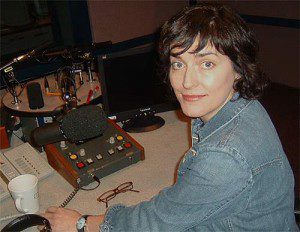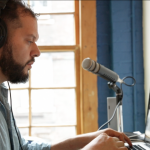Lighting a Spark
The producers of Spark, a weekly show about technology and how it affects culture, have come up with a different way to do radio—they ask listeners for feedback before the program airs. Is that a good idea?

Nora Young, host of CBC Radio’s new tech show, in her studio
(Photo by: William Stodalka)
As I pull out my high-tech Sony recorder, the producer, Elizabeth Bowie, startles me. She stares at it and says, “Oh, look at that”—and I thought Nora Young, Dan Misener and Bowie, the people behind the technology-based radio show and podcast Spark would laugh at my two-year-old digital recorder. But of course, the show’s website says Spark is “not just technology for gearheads, it’s about the way technology affects our lives, and the world around us.”
Last September, Spark—created by radio host, producer and journalist, Nora Young—debuted on CBC Radio One. Young and co-producers Elizabeth Bowie and Dan Misener had big ideas about how to encourage collective storytelling. Instead of accepting feedback from its listeners after an episode, Spark allows its audience to give input on stories before it goes on air. With the fusion of creators and audience, Spark has changed traditional story production by pooling a mixture of perspectives to create a more authoritative voice.
To do this, the producers read the responses to the blogs they’ve posted and the posts on the message board; they also listen to audience phone calls. A producer might also contact someone who leaves a particularly interesting comment or message. “It’s a great way to do a lot of imaginative and thought-provoking things,” says Young, “without having to spend a lot of money, which gives you a huge amount of freedom.”
Using the newly installed SocialText, which is a wiki (a collaborative website that allows users to discuss and add content on a continuing basis), listeners can suggest ideas on show topics, add their knowledge, contribute questions for upcoming guests and interact with Young and the rest of the staff. Sparkexperimented with the wiki in February, airing “The Collaboration Show,” an entire episode comprised of input from the audience on a script posted online. All this interactivity means listeners now have the ability to help decide what will make it on air.
This is how it works: a producer posts an idea or observation on the blog and asks for feedback with questions such as, “Is this you? Do you have a funny story about helping your parent out?” She waits, usually a week, to collect comments and anecdotes before editing the information, which Young will later use during her interviews. Completed interviews then go up on the blog and listeners have a chance to comment. The final show has all these layers. Because audience reactions are less of an afterthought—less “here’s the show, what do you think, audience?”—it makes for a more informative, insightful and often funny program.
Misener explains this journalism mash-up best when he says that part of the appeal of Spark is that the process is cooked into the show itself. “When Nora is doing an interview and she can immediately cut to a question that someone posted on the blog for that particular interview … I think that’s really neat and I, as a listener, would like to hear more of [that].”
After the show airs, it becomes a podcast. “What we’ve been doing for the last several years, around things like podcasting, is that we’ve been trying to pilot things and experiment to see where we should be and how valuable it is for us,” says Steve Pratt, director of radio digital programming for CBC Radio 3. So far, audiences seem to really like the format.
As great as this all sounds, the question remains: will the voice and perspective of a self-selecting group of CBC listeners ever prove to be more popular than that of a team of trained, reputable journalists? “Traditional radio itself still has far larger numbers and I don’t see that collapsing overnight,” says Pratt. “I think the interesting thing is that different people are choosing to do it in different ways.” Young adds, “There are different audiences and I think this is the reality that all media are going to have to start thinking more of as we start spreading across different platforms.”
Spark is a fresh way of understanding how a story can be made, and it benefits from not having a single voice, a single point of view or a single agenda. “I think it is relinquishing a bit of that know-it-all control aspect and recognizing that maybe you don’t know all the answers; there are people in your audience who might know more about the subject than you do,” says Young. “And that’s all for the good, I think.”
by Jasmyn Burke
Jasmyn Burke was the Director of Marketing for the Summer 2008 issue of the Ryerson Review of Journalism.








































